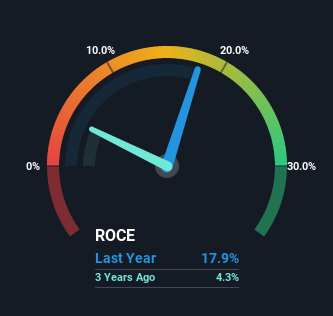- Australia
- /
- Oil and Gas
- /
- ASX:VEA
Viva Energy Group (ASX:VEA) Is Looking To Continue Growing Its Returns On Capital
To find a multi-bagger stock, what are the underlying trends we should look for in a business? Ideally, a business will show two trends; firstly a growing return on capital employed (ROCE) and secondly, an increasing amount of capital employed. Put simply, these types of businesses are compounding machines, meaning they are continually reinvesting their earnings at ever-higher rates of return. With that in mind, we've noticed some promising trends at Viva Energy Group (ASX:VEA) so let's look a bit deeper.
Understanding Return On Capital Employed (ROCE)
For those that aren't sure what ROCE is, it measures the amount of pre-tax profits a company can generate from the capital employed in its business. Analysts use this formula to calculate it for Viva Energy Group:
Return on Capital Employed = Earnings Before Interest and Tax (EBIT) ÷ (Total Assets - Current Liabilities)
0.18 = AU$875m ÷ (AU$8.6b - AU$3.7b) (Based on the trailing twelve months to December 2022).
Therefore, Viva Energy Group has an ROCE of 18%. That's a relatively normal return on capital, and it's around the 15% generated by the Oil and Gas industry.
See our latest analysis for Viva Energy Group

Above you can see how the current ROCE for Viva Energy Group compares to its prior returns on capital, but there's only so much you can tell from the past. If you'd like, you can check out the forecasts from the analysts covering Viva Energy Group here for free.
The Trend Of ROCE
Viva Energy Group is displaying some positive trends. Over the last five years, returns on capital employed have risen substantially to 18%. The company is effectively making more money per dollar of capital used, and it's worth noting that the amount of capital has increased too, by 82%. So we're very much inspired by what we're seeing at Viva Energy Group thanks to its ability to profitably reinvest capital.
On a separate but related note, it's important to know that Viva Energy Group has a current liabilities to total assets ratio of 43%, which we'd consider pretty high. This can bring about some risks because the company is basically operating with a rather large reliance on its suppliers or other sorts of short-term creditors. While it's not necessarily a bad thing, it can be beneficial if this ratio is lower.
The Key Takeaway
To sum it up, Viva Energy Group has proven it can reinvest in the business and generate higher returns on that capital employed, which is terrific. Since the stock has returned a staggering 136% to shareholders over the last three years, it looks like investors are recognizing these changes. With that being said, we still think the promising fundamentals mean the company deserves some further due diligence.
On a final note, we found 2 warning signs for Viva Energy Group (1 is significant) you should be aware of.
While Viva Energy Group isn't earning the highest return, check out this free list of companies that are earning high returns on equity with solid balance sheets.
New: Manage All Your Stock Portfolios in One Place
We've created the ultimate portfolio companion for stock investors, and it's free.
• Connect an unlimited number of Portfolios and see your total in one currency
• Be alerted to new Warning Signs or Risks via email or mobile
• Track the Fair Value of your stocks
Have feedback on this article? Concerned about the content? Get in touch with us directly. Alternatively, email editorial-team (at) simplywallst.com.
This article by Simply Wall St is general in nature. We provide commentary based on historical data and analyst forecasts only using an unbiased methodology and our articles are not intended to be financial advice. It does not constitute a recommendation to buy or sell any stock, and does not take account of your objectives, or your financial situation. We aim to bring you long-term focused analysis driven by fundamental data. Note that our analysis may not factor in the latest price-sensitive company announcements or qualitative material. Simply Wall St has no position in any stocks mentioned.
About ASX:VEA
Viva Energy Group
Operates as an energy company in Australia, Singapore, and Papua New Guinea.
Undervalued with reasonable growth potential.
Similar Companies
Market Insights
Community Narratives




